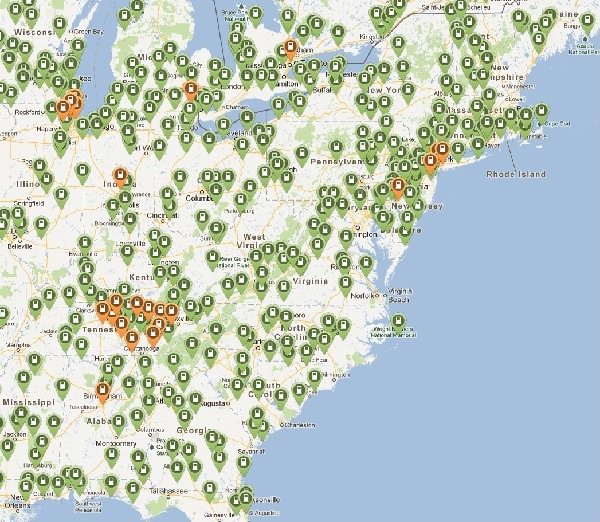
West Coast strength proves infrastructure helps sales
This week Nissan announced that LEAF sales passed the 25,000 mark in the US and over 60,000 worldwide. Recognizing that electric vehicle (EV) sales drive infrastructure build-out, Nissan also acknowledges that infrastructure build-out drives EV sales.
“We’ve also learned how infrastructure plays a role in a consumer’s decision to go all-electric,” according to Brendan Jones, Nissan’s director of EV infrastructure strategy and deployment. “We already knew that areas with a higher concentration of EVs would require more charging stations, but trends show that the reverse is also true—a more robust charging infrastructure generates greater interest in EVs and stimulates more EV driving among EV owners.” Nissan states that the LEAF sales remain strong in the original launch markets of Los Angeles, Portland, San Diego, San Francisco, and Seattle. To show the correlation more graphically, we’ve pulled some screenshots from plugshare.com, the crowd-sourced site that shows all charge stations that EV drivers have placed on the map. We have limited the selection to show only Level 2 and Level 3 (Direct Current Quick Charge or DCQC) charge stations. The Level 2 (240-volt units) are represented by the green points and the Level 3 (440-volt quick charge units) are indicated by the orange points. We’ll show you the West Coast first.

One can see that the EV highway absolutely exists from the Canadian border down Interstate 5 to the southern state line of Oregon, where it comes to a screeching halt. It can also be seen that it would be relatively easy to travel around the greater Seattle area or the greater Portland area with ease without having to wait hours for your car to recharge. Once California is entered however, we see a different story. The greater San Francisco area provides a growing cluster of DCQC stations, as does Los Angeles/Orange County. The San Diego area is still sorely lacking the high-powered units in quantity. It would still be difficult to travel just from San Diego to Northern Los Angeles without some careful planning and DCQC location plotting unless waiting for a slow L2 charge is in your future. Keep in mind that the LEAF is primarily a shorter distance vehicle for most families, and one can see that if you plan to travel primarily around your home turf in SoCal, you are probably still in pretty good shape with loads of L2 stations to be found. The East Coast, however, is a different story.

In the Eastern US, Level 2 charge stations are more in evidence than they are in the West, but that is due to the population distribution. L2 stations abound in the Northeast, but become much less abundant as one moves south. There is a lack of DCQC infrastructure development throughout. In Tennessee the Cracker Barrel restaurant chain stepped up and installed a dozen DCQC stations to facilitate easier movement around Nissan’s home state in the US. The vast majority of the Eastern Seaboard however lacks a significant DCQC presence.
This is a nationwide illustration of the old conundrum – which came first the EV or the infrastructure (although many may use chicken and egg, we think that you probably get the point). It seems that to see any significant improvement in EV adoption, infrastructure development needs to be promoted simultaneously.
Nissan claimed that the LEAF was Nissan’s strongest selling vehicle in San Francisco in April. So we thought we would check their claim. Checking the LEAF inventory at Boardwalk Nissan in Redwood City we found a current LEAF inventory of 71 units. In fact, they had more LEAFs in stock than any other model. Boardwalk claims to be Nissan’s number one LEAF selling dealership in the country on their website. Moving north to Nissan of the East Side in Bellevue, Washington (near Seattle), we found 76 LEAFs in stock, again, more than any other model. This would certainly seem to back Nissan’s claim of strong sales in the Northwest because you can’t sell what you don’t have. Dealers will not order cars that don’t sell if they can avoid it.
So it would seem that Nissan’s current efforts at expanding the DCQC infrastructure from 200 to 600 throughout the country this year will, in fact, improve the odds of seeing more LEAFs running around. After all you know the old saying, it’s better to have a quick charger and not need it, than need it and not have it.
